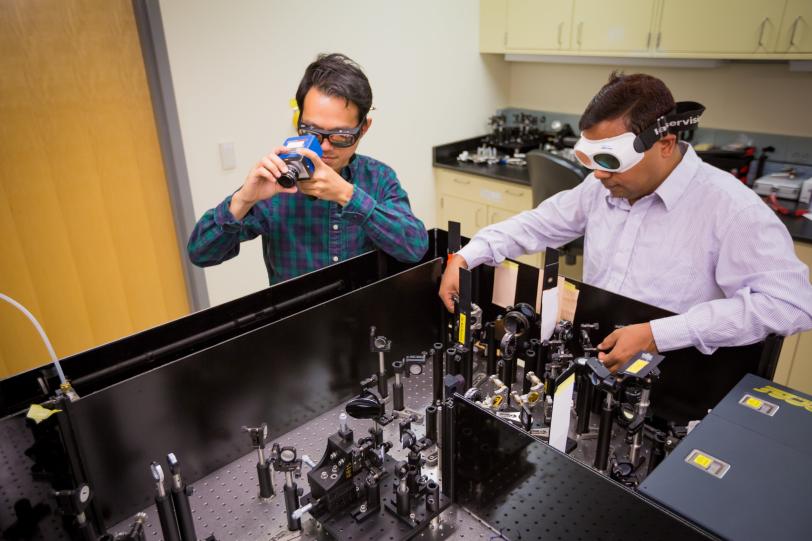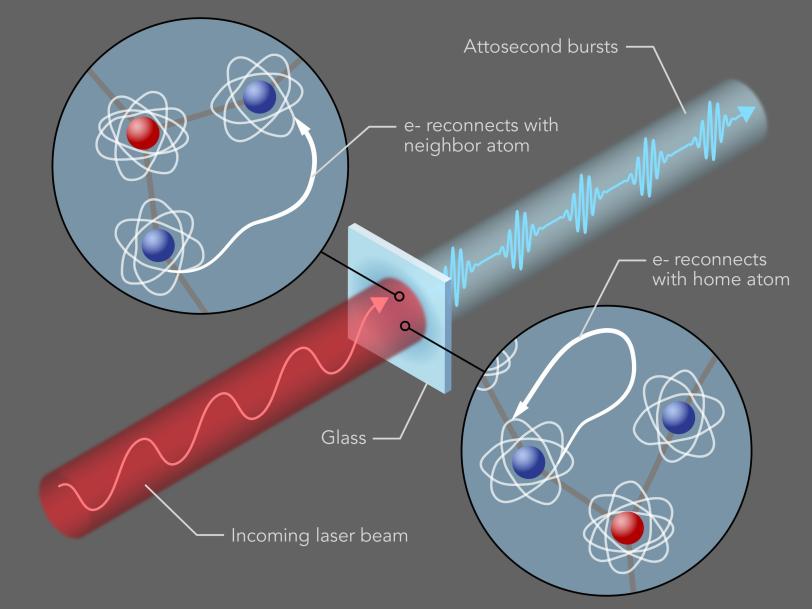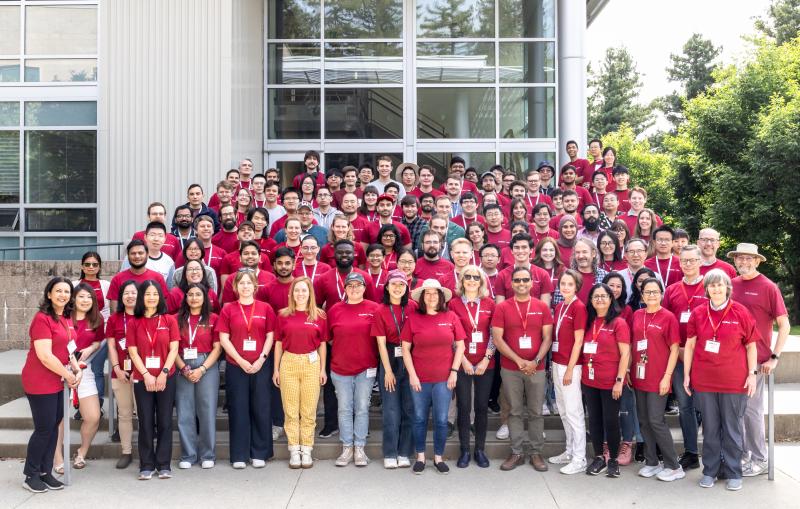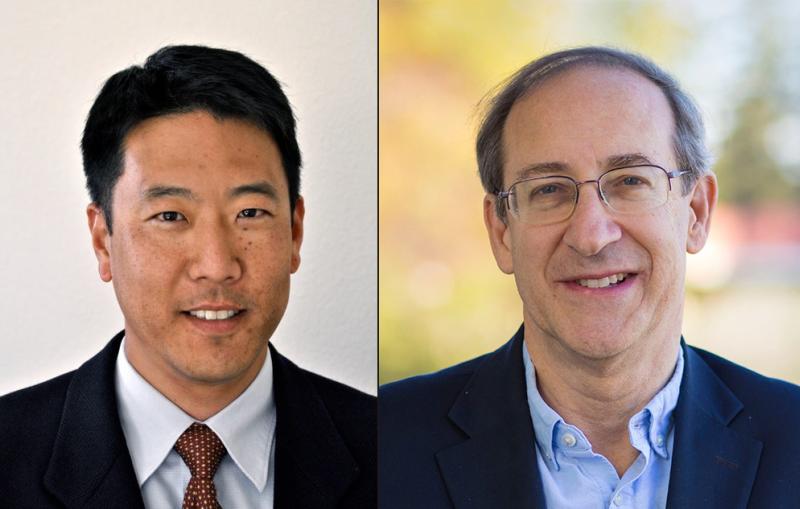A Potential New and Easy Way to Make Attosecond Laser Pulses: Focus a Laser on Ordinary Glass
This novel method could shrink the equipment needed to make laser pulses that are billionths of a billionth of a second long for studying ultra-speedy electron movements in solids, chemical reactions and future electronics.
By Glennda Chui
The discovery 30 years ago that laser light can be boosted to much higher energies and shorter pulses - just billionths of a billionth of a second, or attoseconds, long - is the basis of attosecond science, where researchers observe and try to control the movements of electrons. Electrons are key players in chemical reactions, biological processes, electronics, solar cells and other technologies, and only pulses this short can make snapshots of their incredibly swift moves.
Now scientists from the Stanford PULSE Institute at the Department of Energy’s SLAC National Accelerator Laboratory have found a potential new way to make attosecond laser pulses using ordinary glass - in this case, the cover slip from a microscope slide.
The discovery, reported in Nature Communications today, was a real surprise and opens new possibilities for attosecond science and technology, including the ability to probe ultra-speedy electron motions inside glasses and other solid materials. It could also dramatically shrink the size and cost of the setups needed to produce these tiny pulses, to the point where you might be able to generate pulses inside a fiber optic cable that delivers them to where they’re needed.
“With today’s methods, you have to shine the laser beam through a special gas jet or through a crystal that has to be grown with great care at ultra-cold temperatures,” said Yong Sing You, a postdoctoral researcher at PULSE and lead author of the study. “But this is exciting because you can use everyday glass, which is cheap and easily available, at room temperature. If you were to put your eyeglasses into the experiment, it would still work, and it would not even damage the glasses.”

A String of Surprises
The process that generates attosecond laser pulses is called high harmonic generation, or HHG. Much like pressing on a guitar string produces a note that’s higher in pitch, shining laser light through certain materials changes the nature of the light, shifting it to higher energies and shorter pulses than a laser can reach on its own.
Most of the time this is done in a gas. Incoming photons, or particles of light, from the laser hit atoms in the gas and liberate some of their electrons. The freed electrons fly away, loop back and reconnect with their home atoms. This reconnection generates attosecond bursts of light that combine to form an attosecond laser pulse.
Starting in 2010, a series of experiments led by PULSE researchers Shambhu Ghimire and David Reis showed HHG can be produced in ways that were previously thought unlikely or even impossible: by beaming laser light into a crystal, frozen argon gas or an atomically thin semiconductor material.
Unlike a gas, whose atoms are so far apart that you can think of them as behaving independently, atoms in a solid are so close together that scientists thought electrons freed by an incoming laser pulse would hit neighboring atoms, scatter and never return home to make that crucial reconnection. But it turned out this was not the case, Reis said: “There’s something about the orderly structure of the crystal that allows electrons to move throughout the lattice in a way that doesn’t dissipate their energy or give them a kick in some other direction. Even if they connect with a neighboring atom, they can still participate in HHG.”
Fundamental Science with Practical Potential
The fact that glass could generate HHG was also a surprise, said Ghimire, who helped lead the latest study. Because it’s amorphous, meaning that its silicon and oxygen atoms are arranged in no particular order, it did not seem like a good candidate.
But glass’s random nature was just what the team needed to answer the fundamental scientific question at the heart of the study: How do the density and crystallinity of a material - the degree to which its atoms are arranged in an orderly lattice – independently affect its ability to produce HHG? A piece of glass and a quartz crystal are both made of silicon and oxygen, and they’re roughly the same density; only the arrangement of their atoms is different. So comparing the two should provide some answers.
The scientists put the glass cover slip in their apparatus and hit it with pulses from their infrared laser beam.
“You might think, again, that this wouldn’t work, because the electrons would bounce off their neighbors and never make it back home,” said Reis, who was not involved in the current paper. “But the surprising thing is that even in glass, if you hit the glass hard enough but not so hard that you break it, it works fine, although by a slightly different process.”
The ability to produce HHG in glass and other solids is exciting, he said, because it has the potential to shrink the equipment needed to do this from the size of a lab bench to maybe just a few nanometers - billionths of a meter - in size.
Ghimire added that producing harmonics in glass has potential technological applications. For instance, it produces the short wavelengths of laser light needed to design masks for patterning nanometer-scale features on semiconductor chips.
“For this, they want as much intensity as possible, and also an easy way to deliver light to their samples,” he said. “Being able to produce short-wavelength laser light in normal glass would bring us a couple of steps closer to something they could actually use. We could even generate the short-wavelength light in the glass portion of optical fibers that then deliver it to wherever they wanted it.”
The Stanford PULSE Institute is an independent laboratory of Stanford University as well as a research center within the SLAC Science Directorate. This research was done in collaboration with scientists at the University of Central Florida. The DOE Office of Science funded the work at PULSE through an Early Career Research Program award to Ghimire. The work in Florida was funded by the Air Force Office of Scientific Research, the Army Research Office, the DARPA PULSE program and the National Science Foundation.
Citation: Y.S. You et al., Nature Communications, 28 September 2017 (10.1038/s41467-017-00989-4)
Contact
For questions or comments, contact the SLAC Office of Communications at communications@slac.stanford.edu.
SLAC is a multi-program laboratory exploring frontier questions in photon science, astrophysics, particle physics and accelerator research. Located in Menlo Park, Calif., SLAC is operated by Stanford University for the U.S. Department of Energy's Office of Science.
SLAC National Accelerator Laboratory is supported by the Office of Science of the U.S. Department of Energy. The Office of Science is the single largest supporter of basic research in the physical sciences in the United States, and is working to address some of the most pressing challenges of our time. For more information, please visit science.energy.gov.






